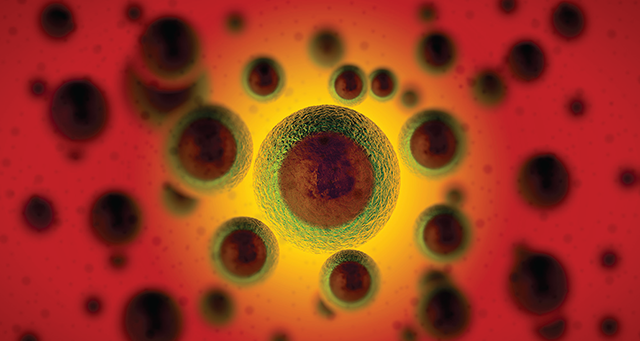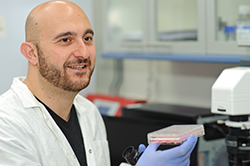
The reason that embryonic stem cells are so appealing is their power: they can give rise to any cell type in the body. This means they could be used to repair damaged tissue, treat autoimmune diseases, and even grow transplant organs. However, in the U.S. and elsewhere, research using embryonic stem cells is severely limited due to religious or ethical issues, as well as limited availability. In order to advance the use of stem cells in medicine, another way must be found – and that’s why Dr. Jacob (Yaqub) Hanna of the Weizmann Institute of Science’s Department of Molecular Genetics is seeking to harness the potential of embryonic stem cells while avoiding the pitfalls.
Dr. Hanna’s method shortened the time needed to produce induced pluripotent stem cells from four weeks to eight days, and increased the efficiency from 1 percent or less to 100 percent.
This still-young field of research is changing fast. In 2006, Shinya Yamanaka of Kyoto University discovered that it’s possible to “reprogram” adult cells so that they return to an embryonic stem cell-like state; a mere six years later, he won the Nobel Prize for this work. To create these cells, known as induced pluripotent stem (iPS) cells, Yamanaka inserted four genes into the genomes of adult skin cells – a method now known as “expressing the four Yamanaka factors.” However, the process of creating iPS cells has been frustratingly slow and inefficient, rendering them difficult formedical use.
But then, as he described in a paper in Nature, Dr. Hanna discovered that if – after expressing the four Yamanaka factors – he removed a single protein, MBD3, from adult cells, the efficiency of the process improved dramatically. In fact, the time needed to produce iPS cells was shortened from four weeks to eight days.
“What we discovered is that the MBD3 protein acts as a brake on reprogramming. If you remove the brakes, the cells will swiftly become iPS cells,” says Dr. Hanna. In fact, releasing this brake increased efficiency from 1 percent or less to 100 percent. It is hoped that these findings will make it possible to produce large amounts of stem cells on demand.

Dr. Jacob (Yaqub) Hanna
Another obstacle to employing iPS cells for medical use is that they retain signs of “priming” – commitment to specific cell lineages. Scientists were unable to efficiently keep reprogrammed iPS cells in their pristine, or “naïve,” state.
In another study that appeared in Nature, Dr. Hanna and his colleagues revealed that they had created iPS cells that are not only completely “reset” to the earliest possible state, but they were able to keep them that way. The scientists worked out a “treatment” for human iPS cells, effectively damping down the genetic pathway for differentiation. Next, they injected the treated iPS cells into mouse blastocysts – early-stage embryos containing only a few cells. If the iPS cells were truly naïve, as well as viable, the team reasoned, they should grow with the mouse cells. To find out, the researchers added a fluorescent marker to the iPS cells so that they could trace them in the developing embryo. And indeed, fluorescent imaging after 10 days revealed that the embryos did contain both mouse and human tissues.
“We were stunned that this actually works,” says Dr. Hanna. “We are seeing human tissues inside another living animal.”
This research could pave the way toward growing transplant organs to order. It may also establish a new platform for modeling human disease; for example, it might be possible to inject human iPS cells into a mouse so that it will have human bone marrow. Scientists could then use the mouse as a model for studying human blood diseases.
Dr. Hanna was able to “reset” iPS cells to the earliest possible state by stopping a single protein. This could lead to the ability to grow organs on demand.
Dr. Hanna’s interest in medicine comes naturally: born and raised in the Galilee, his grandfather, father, and three sisters are all doctors. In keeping with the family tradition, he initially studied medicine, but ultimately found that he had more passion for research. After receiving his MD and PhD, he conducted postdoctoral research at MIT’s Whitehead Institute for Biomedical Research, where he worked in one of the first three labs in the world that was able to reprogram mouse skin cells into iPS cells. He also used iPS cells to treat sickle-cell anemia in mice, the first-ever proof of concept of the therapeutic application of iPS.
After such groundbreaking work, Dr. Hanna had his choice of where to establish his lab, but the Weizmann Institute – and Israel – won out in 2011. Dr. Hanna saidthat he wanted to “live near my friends, my family, and to be in the environment I grew up in, even with all its problems and complexities.” In addition, the Institute gave him the freedom and flexibility to pursue risky, ambitious research right from the start. “The Weizmann Institute is very selective about who they recruit. But once they choose you, they really give you the funding and infrastructure you need,” says Dr. Hanna, whose new lab was built to his specifications. He adds, “My intuition about the Institute was right, and I’m very happy here.”
Needless to say, the Institute feels the same way about him.
Dr. Jacob Hanna's research is supported by Pascal and Ilana Mantoux, France/Israel; The Benoziyo Endowment Fund for the Advancement of Science; the Leona M. and Harry B. Helmsley Charitable Trust; The Sir Charles Clore Research Prize; Erica A. Drake and Robert Drake; the European Research Council; and the Fritz Thyssen Stiftung.
